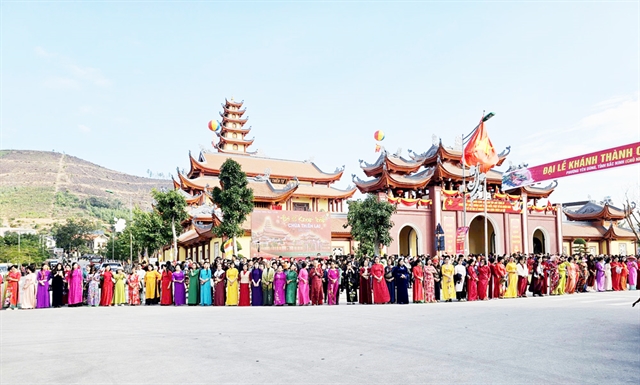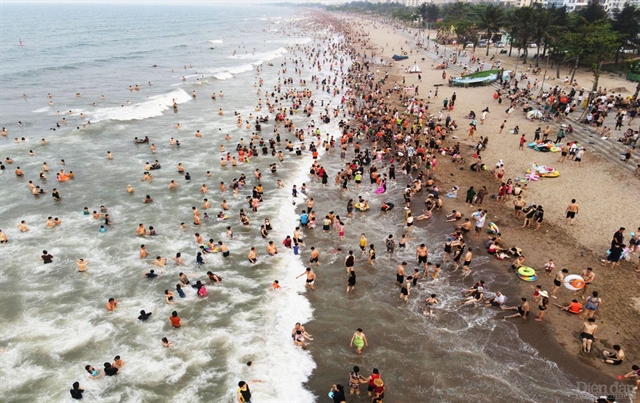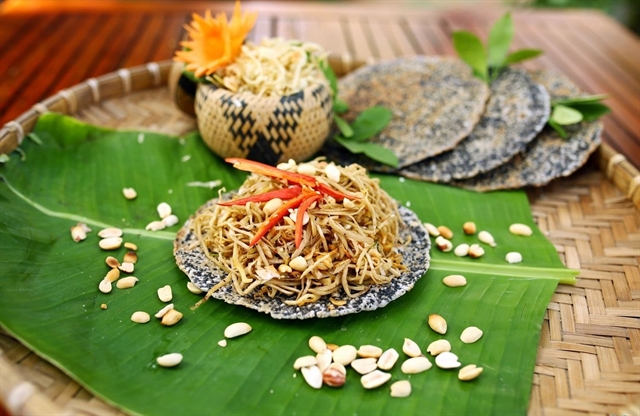 Life & Style
Life & Style


|
| Nghệ An cuisine never fails to captivate visitors with its richness and uniqueness, especially the province’s iconic eel dishes. — Photo laodong.vn |
NGHỆ AN — With its rich culinary traditions and distinctive local flavours, Nghệ An is turning its cuisine into a powerful “golden key” to attract visitors and strengthen its tourism brand.
Nghệ An is not only famous for its historical sites and majestic landscapes but also an attractive destination thanks to its distinctive and flavourful cuisine.
From humble local dishes to renowned specialties, Nghệ An’s gastronomy is becoming a “golden key” to enhancing its tourism appeal and solidifying its local brand identity.
Culinary ambassadors for tourism
Nghệ An cuisine never fails to captivate visitors with its richness and uniqueness, especially the province’s iconic eel dishes.
Whether it’s the creamy eel soup, nutritious eel porridge, or eel stewed with banana and tofu, each dish leaves a memorable impression on diners.
Located on Lê Mao Street, Trường Vinh Ward, Hoa Lan Eel Restaurant has long been a must-visit stop for travellers seeking authentic eel dishes. The restaurant specialises in soups, porridge, and vermicelli with eel.
To create such delicious and appealing flavours, Hoa Lan carefully selects fresh ingredients and meticulously prepares each dish to ensure customer satisfaction. Diners often praise the restaurant for its rich flavours and reasonable prices.
“Every dish is made with carefully selected ingredients and rich seasoning to deliver the best taste experience. For example, our eel soup features a clear, delicate broth, tender and aromatic eel meat that doesn’t fall apart, an unforgettable flavour for anyone who tries it. Many visitors not only enjoy it here but also buy it to take home as a gift or for daily meals,” Nguyễn Thị Lan, owner of Hoa Lan Eel Restaurant, said.
“Hoa Lan’s eel soup is a ‘must-try' dish for my family whenever we return to Nghệ An. It captures the authentic flavour of Nghệ An, with eye-catching colours, rich eel meat, and soft, chewy bánh mướt (steamed rice rolls). We’re truly impressed with both the quality and the fair prices,” Kiều Ly, a tourist from Hà Nội, said.
Beyond eel dishes, Nghệ An boasts a variety of rustic yet irresistible delicacies such as bánh mướt, Nam Đàn soy sauce, lotus-based dishes, and coastal specialties like Cửa Lò squid.
Other local favourites include bánh đa xúc hến (sesame rice crackers with clams), cháo canh (thick noodle soup), giò bê or giò me (veal or goat sausage), nhút mít (pickled jackfruit), Xã Đoài oranges, and regional treats like bánh đa vừng (sesame rice paper), banh ngào (glutinous honey cake), mắm nhút (fermented jackfruit sauce), green tea, bitter bamboo shoots, thịt chua (fermented pork), and măng muối (pickled bamboo), among others.
Nghệ An’s cuisine is regarded as a key factor in boosting tourism appeal. While the dishes may not be luxurious, they embody the simple, hardworking, and sincere spirit of Nghệ An’s people.
In recent years, localities and businesses have effectively incorporated cuisine into tourism services, especially within cultural and agro-experience tours.
“During our tours, we often receive great feedback from travelers about the local food. Culinary tourism is not only about tasting but also about bringing home authentic, locally made specialties as gifts. These simple yet traditional dishes reflect the cultural identity of Nghệ An’s people,” said Nguyễn Huỳnh Sương, director of Đông Dương Travel Joint Stock Company.

|
| Culinary culture plays a vital role in connecting tourism services to create attractive products. — Photo laodong.vn |
A “lever” for tourism growth
Culinary experiences are increasingly being integrated into tourism programmes, particularly those focused on local culture in Nghệ An.
By introducing regional traditions, culinary culture plays a vital role in connecting tourism services to create attractive products.
A destination’s distinctive food culture helps attract more visitors, extend their stay, increase average spending, and boost local tourism revenue.
The dish grilled chicken with tea leaves has become a specialty of Hoa Quân Commune, charming visitors who come to explore the area’s tea hills.
Many restaurants and homestays in the region now include it in their main menus, often pairing it with eco-tourism experiences like tea picking, boating, and visiting tea islets, all contributing to spreading the unique culinary identity of Nghệ An.
“The uniqueness of this dish lies not only in its preparation but also in the setting where it’s enjoyed. Tasting a delicious meal amidst the fresh, peaceful green hills creates an unforgettable experience. That’s why culinary tourism is one of our key development strategies toward green and sustainable tourism,” Nguyễn Thế Cường, chairman of Hoa Quân Commune People’s Committee, said.
According to travel businesses, cuisine plays an essential role in tourism. It is an indispensable part of any tour package and acts as a cultural ambassador introducing the destination to visitors.
To enhance tourist experiences, tour operators should design immersive culinary activities such as regional food festivals, countryside food fairs, cooking classes, and culinary-themed tours that showcase the best of Vietnamese cuisine.
Võ Hồng Sáng, director of Thái Sơn International Travel Joint Stock Company, suggested: “We should develop themed culinary tours such as the ‘Vinh Eel Discovery Tour’ or the ‘Taste of the Lam River Tour’. At the same time, combining culinary tourism with visits to traditional craft villages would help tourists better understand ingredient origins and production processes.”

|
| Nghệ An is not only famous for its historical sites and majestic landscapes but also an attractive destination thanks to its distinctive and flavourful cuisine. —Photo bvhttdl.gov.vn |
To make Nghệ An’s cuisine a true “driving force” for tourism, coordinated and creative measures are needed.
These include building a distinctive culinary brand, helping local eateries establish food safety standards while preserving traditional flavours, organising culinary contests, and recognising “Typical Nghệ An dishes and restaurants” with official certification.
Trương Quốc Hùng, chairman of the UNESCO Hà Nội Travel Club, proposed: “We need to promote through multi-channel media, using TikTok, Facebook, and YouTube to produce videos and articles about dishes, their stories, and the people behind them. Invite food bloggers and influencers to experience and review the cuisine.
"The Department of Culture should also build an online culinary map (website/app) with detailed information on reputable restaurants, specialty stores, ratings, and navigation.”
In reality, Nghệ An’s culinary tourism still faces challenges as some cultural food values have been distorted or lost, products lack creativity and are overly commercialised, and service quality remains inconsistent.
Moreover, local cuisine has not yet been developed as an independent tourism product, often being included only as part of other tour programmes, thus limiting its potential.
Trần Xuân Cường, deputy director of the Nghệ An Department of Culture, Sports and Tourism, said: “Building the brand ‘Nghệ An - The Capital of Cuisine’ is a strategic move to promote tourism through celebrating the province’s rich culinary heritage. This positioning not only gives Nghệ An tourism a new and attractive identity but also helps preserve traditional cultural values.”
Accordingly, the province plans to develop brands for various types of cuisine; design a unified culinary identity system and standardised restaurant network; revive traditional local dishes; organise specialised culinary tours and related events such as festivals, seminars, chef competitions, and training programmes.
Nghệ An also aims to preserve and spread its culinary heritage through communication campaigns, community awareness programmes, and partnerships both domestically and internationally for more effective and professional promotion.
With its diversity, uniqueness, and rich cultural essence, Nghệ An cuisine holds tremendous potential to become a major attraction for visitors.
By implementing creative solutions, professionalising culinary experiences, and strengthening promotion efforts, Nghệ An is poised to win the hearts of all food lovers and elevate its tourism to new heights. — VNS